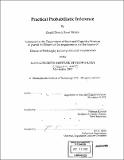Practical probabilistic inference
Author(s)
Morris, Quaid Donald Jozef, 1972-
DownloadFull printable version (5.352Mb)
Other Contributors
Massachusetts Institute of Technology. Dept. of Brain and Cognitive Sciences.
Advisor
Whitman Richards.
Terms of use
Metadata
Show full item recordAbstract
The design and use of expert systems for medical diagnosis remains an attractive goal. One such system, the Quick Medical Reference, Decision Theoretic (QMR-DT), is based on a Bayesian network. This very large-scale network models the appearance and manifestation of disease and has approximately 600 unobservable nodes and 4000 observable nodes that represent, respectively, the presence and measurable manifestation of disease in a patient. Exact inference of posterior distributions over the disease nodes is extremely intractable using generic algorithms. Inference can be made much more efficient by exploiting the QMR-DT's unique structure. Indeed, tailor-made inference algorithms for the QMR-DT efficiently generate exact disease posterior marginals for some diagnostic problems and accurate approximate posteriors for others. In this thesis, I identify a risk with using the QMR-DT disease posteriors for medical diagnosis. Specifically, I show that patients and physicians conspire to preferentially report findings that suggest the presence of disease. Because the QMR-DT does not contain an explicit model of this reporting bias, its disease posteriors may not be useful for diagnosis. Correcting these posteriors requires augmenting the QMR-DT with additional variables and dependencies that model the diagnostic procedure. I introduce the diagnostic QMR-DT (dQMR-DT), a Bayesian network containing both the QMR-DT and a simple model of the diagnostic procedure. Using diagnostic problems sampled from the dQMR-DT, I show the danger of doing diagnosis using disease posteriors from the unaugmented QMR-DT. (cont.) I introduce a new class of approximate inference methods, based on feed-forward neural networks, for both the QMR-DT and the dQMR-DT. I show that these methods, recognition models, generate accurate approximate posteriors on the QMR-DT, on the dQMR-DT, and on a version of the dQMR-DT specified only indirectly through a set of presolved diagnostic problems.
Description
Thesis (Ph. D. in Computational Neuroscience)--Massachusetts Institute of Technology, Dept. of Brain and Cognitive Sciences, 2003. Includes bibliographical references (leaves 157-163).
Date issued
2003Department
Massachusetts Institute of Technology. Department of Brain and Cognitive SciencesPublisher
Massachusetts Institute of Technology
Keywords
Brain and Cognitive Sciences.